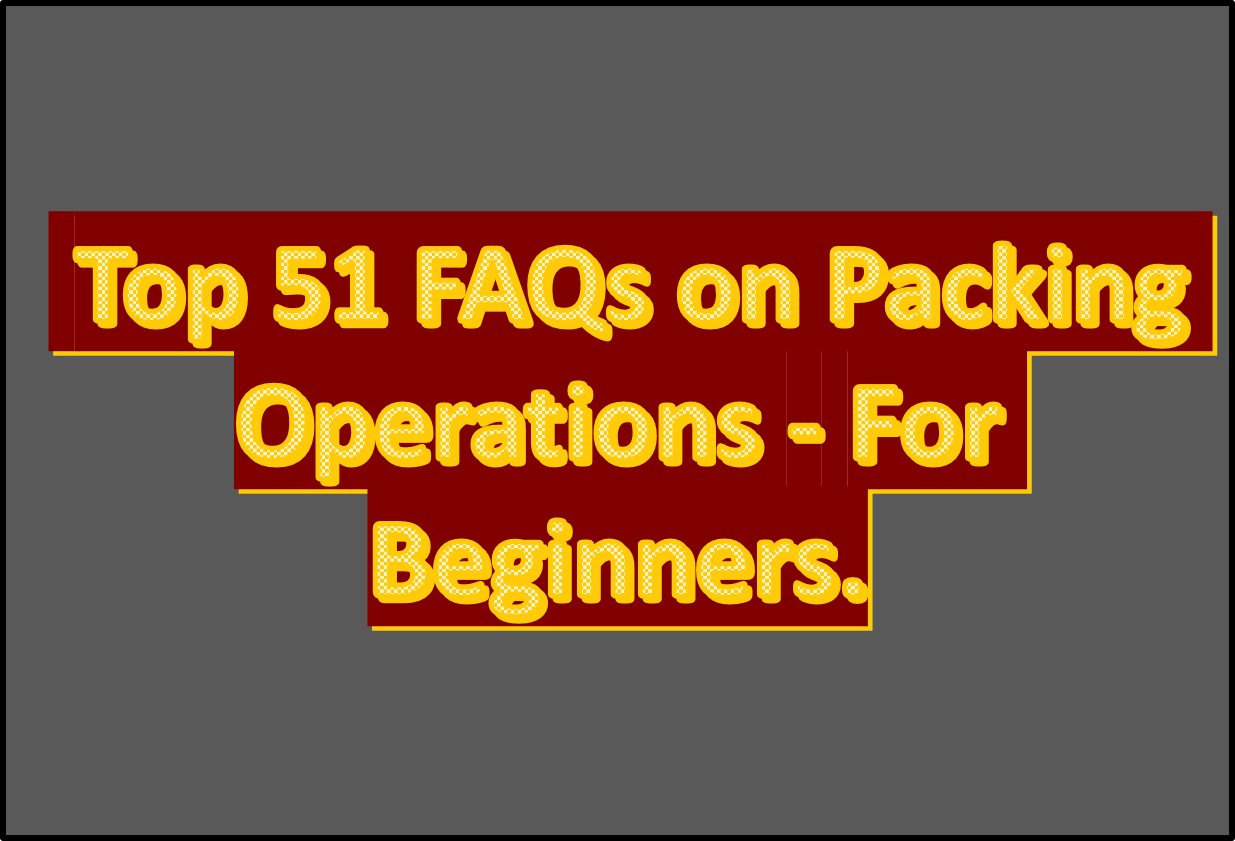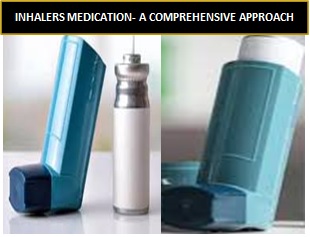Top 51 FAQs on Packing Operations – For Beginners.

FAQs on packing operations
It includes Top 59 Frequently asked Questions with answers FAQs on Packing Operations for Pharmaceutical Products – For Beginners :
(Frequently asked Questions) FAQs on Packing Operations for Pharmaceutical Products – It’s for Beginners :
- What is packing in the pharmaceutical industry?
Packing refers to the process of packaging drugs in the appropriate containers and labeling them for distribution. - Why is packing important in the pharmaceutical industry?
Packing ensures that drugs are properly labeled, stored, and protected from damage, contamination, and tampering. - What are the types of packing in the pharmaceutical industry?
The types of packing in the pharmaceutical industry include primary packing, secondary packing, and tertiary packing. - What is primary packing?
Primary packing refers to the first layer of packaging that comes into direct contact with the drug product, such as bottles, blister packs, ampoules, and vials. - What is secondary packing?
Secondary packing refers to the packaging that contains the primary package, such as cartons, labels, leaflets, and shrink wrap. - What is tertiary packing?
Tertiary packing refers to the packaging that is used to transport and store the secondary packages, such as shipping boxes and pallets. - What are the materials used for primary packing in the pharmaceutical industry?
The materials used for primary packing in the pharmaceutical industry include glass, plastic, metal, and rubber. - What are the materials used for secondary packing in the pharmaceutical industry?
The materials used for secondary packing in the pharmaceutical industry include paper, cardboard, and plastic. - What are the materials used for tertiary packing in the pharmaceutical industry?
The materials used for tertiary packing in the pharmaceutical industry include corrugated cardboard, wooden crates, and plastic pallets. - What is the difference between primary and secondary packaging in the pharmaceutical industry?
Primary packaging is the packaging that directly contains the drug product, while secondary packaging is the packaging that contains one or more primary packages and provides additional protection, information, and convenience. - What are the labeling requirements for pharmaceutical products?
The labeling requirements for pharmaceutical products include the name of the drug, its strength, dosage form, directions for use, warnings, and precautions. - What is the role of labeling in pharmaceutical packaging?
Labeling plays a crucial role in pharmaceutical packaging by providing information about the drug product, such as dosage, administration, warnings, and contraindications, and ensuring compliance with regulatory requirements. - What are the challenges of labeling in pharmaceutical packaging?
The challenges of labeling in pharmaceutical packaging include providing clear and concise information, ensuring readability, and complying with regulatory requirements. - What are the factors to consider in selecting packaging materials in the pharmaceutical industry?
The factors to consider in selecting packaging materials in the pharmaceutical industry include compatibility with the drug product, protection against environmental factors, tamper resistance, ease of use, and regulatory compliance. - What is serialization in the pharmaceutical industry?
Serialization is the process of assigning a unique identification code to each unit of a drug product to track and trace it throughout the supply chain. - What are the benefits of serialization in the pharmaceutical industry?
The benefits of serialization in the pharmaceutical industry include improved product safety, reduced counterfeiting and diversion, and enhanced supply chain visibility. - What are the challenges of serialization in the pharmaceutical industry?
The challenges of serialization in the pharmaceutical industry include the high cost of implementation, the need for interoperability and data exchange, and the risk of data breaches. - What is tamper-evident packaging?
Tamper-evident packaging is a type of packaging that indicates if the product has been opened or tampered with, such as shrink wrap, breakaway seals, or tear tapes. - What are the benefits of tamper-evident packaging in the pharmaceutical industry?
The benefits of tamper-evident packaging in the pharmaceutical industry include improved product safety, reduced liability, and increased consumer confidence. - What is child-resistant packaging?
Child-resistant packaging is a type of packaging that is designed to prevent children from accessing harmful Substances, such as medications, by using special closures or locking mechanisms. but it can be easily opened by adults. - What are the benefits of child-resistant packaging in the pharmaceutical industry?
The benefits of child-resistant packaging in the pharmaceutical industry include preventing accidental ingestion of medication by children, reducing the risk of medication errors, and enhancing patient safety. - What are the regulatory requirements for child-resistant packaging in the pharmaceutical industry?
The regulatory requirements for child-resistant packaging in the pharmaceutical industry include compliance with the Poison Prevention Packaging Act (PPPA) and the Consumer Product Safety Commission (CPSC) regulations. - What is stability testing in the pharmaceutical industry?
Stability testing is the process of evaluating the physical, chemical, and microbiological properties of drug products over time under various storage conditions to determine their shelf life. - Why is stability testing important in the pharmaceutical industry?
Stability testing is important in the pharmaceutical industry to ensure that drugs remain safe and effective throughout their shelf life. - What are the packaging requirements for stability testing in the pharmaceutical industry?
The packaging requirements for stability testing in the pharmaceutical industry include using the same packaging materials, containers, and closure systems as those intended for marketing, and ensuring that the packaging is compatible with the drug product and storage conditions. - What is overwrapping in the pharmaceutical industry?
Overwrapping is the process of wrapping a secondary package with an additional layer of packaging, such as plastic film or paper, to protect it from damage, contamination, or tampering. - What are the benefits of overwrapping in the pharmaceutical industry?
The benefits of overwrapping in the pharmaceutical industry include improved product protection, extended shelf life, and enhanced aesthetics. - What is blister packaging in the pharmaceutical industry?
Blister packaging is a type of primary packaging that consists of a plastic or aluminum cavity that holds the drug product and a backing material, such as paper or aluminium foil, that provides a barrier against moisture and oxygen. - What are the benefits of blister packaging in the pharmaceutical industry?
The benefits of blister packaging in the pharmaceutical industry include improved product protection, enhanced tamper resistance, and increased patient compliance. - What is cold chain packaging in the pharmaceutical industry?
Cold chain packaging is a type of packaging that maintains a specific temperature range during transportation and storage to prevent degradation or loss of potency of temperature-sensitive drugs. - What are the challenges of cold chain packaging in the pharmaceutical industry?
The challenges of cold chain packaging in the pharmaceutical industry include maintaining the temperature range, preventing thermal shock, ensuring adequate insulation, and complying with regulatory requirements. - What is the role of packaging in ensuring patient compliance?
Packaging plays a crucial role in ensuring patient compliance by providing clear instructions, easy-to-use packaging, and reminder systems. - What is repackaging in the pharmaceutical industry?
Repackaging is the process of removing a drug product from its original container and placing it into a new container, such as a medication dispenser or blister pack. - What are the benefits of repackaging in the pharmaceutical industry?
The benefits of repackaging in the pharmaceutical industry include improved patient compliance, reduced medication errors, and enhanced medication management. - What is the difference between repackaging and compounding in the pharmaceutical industry?
Repackaging involves transferring a drug product from its original container to a new container, while compounding involves preparing a drug product from raw materials based on a prescription. - What are the regulatory requirements for repackaging in the pharmaceutical industry?
The regulatory requirements for repackaging in the pharmaceutical industry include compliance with GMP, GDP, and labeling requirements, and ensuring the safety, efficacy, and stability of the drug product. - What is the role of packaging in protecting drugs from environmental factors?
Packaging plays a crucial role in protecting drugs from environmental factors such as moisture, oxygen, light, and temperature, which can degrade or destabilize the drug product. - What is the role of packaging in preventing medication errors?
Packaging plays a crucial role in preventing medication errors by providing clear labeling, appropriate instructions, and easy-to-use packaging. - What is the role of blister packaging in the pharmaceutical industry?
Blister packaging is a type of primary packaging that involves sealing individual doses of medication in a pre-formed plastic or aluminum blister. It provides protection against environmental factors, enhances patient compliance, and ensures accurate dosing. - What are the benefits of unit dose packaging in the pharmaceutical industry?
Unit dose packaging involves packaging a single dose of medication in a pre-measured unit. The benefits include accurate dosing, improved patient compliance, and reduced risk of medication errors. - What is the difference between glass and plastic packaging in the pharmaceutical industry?
Glass packaging is often preferred for parenteral drug products, such as injectables and infusions, because of its inertness, transparency, and ability to withstand sterilization. Plastic packaging is often preferred for oral drug products, such as tablets and capsules, because of its flexibility, durability, and ability to provide barrier protection. - What is the role of packaging in drug stability?
Packaging plays a crucial role in drug stability by protecting the drug product against environmental factors, such as moisture, oxygen, and light, that can degrade the drug and reduce its efficacy. - What is the role of packaging in drug delivery?
Packaging plays a crucial role in drug delivery by providing a means for accurate dosing, ease of administration, and enhanced patient compliance. - What are the challenges of packaging for vaccines in the pharmaceutical industry?
The challenges of packaging for vaccines in the pharmaceutical industry include maintaining stability during transportation and storage, ensuring sterility, and protecting against environmental factors that can affect the efficacy of the vaccine. - What is the role of packaging in preventing drug diversion?
Packaging plays a crucial role in preventing drug diversion by providing tamper-evident and tamper-proof packaging that reduces the risk of counterfeit drugs and unauthorized access to the drug product. - What are the benefits of multi-dose packaging in the pharmaceutical industry?
Multi-dose packaging involves packaging multiple doses of medication in a single container. The benefits include convenience, reduced packaging waste, and improved patient compliance. - What is the role of packaging in preventing medication mix-ups?
Packaging plays a crucial role in preventing medication mix-ups by providing clear instructions, appropriate labeling, and easy-to-use packaging that enable patients to take the correct medication, in the correct dose, at the correct time. - What is the role of packaging in ensuring product integrity?
Packaging plays a crucial role in ensuring product integrity by protecting the drug product against environmental factors, such as moisture, oxygen, and light, that can degrade the drug and reduce its efficacy. - What are the challenges of packaging for controlled substances in the pharmaceutical industry?
The challenges of packaging for controlled substances in the pharmaceutical industry include complying with regulatory requirements, preventing diversion, and ensuring patient safety. - What is the role of packaging in product differentiation?
Packaging plays a crucial role in product differentiation by providing distinctive branding and packaging design that enable patients and healthcare providers to easily recognize the drug product. - What is the role of packaging in product recall?
Packaging plays a crucial role in product recall by providing traceability and ensuring that the recalled product is properly identified and removed from the supply.



